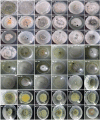Anti-Pseudomonas aeruginosa activity of a C16-terpene dilactone isolated from the endophytic fungus Neofusicoccum luteum of Kigelia africana (Lam.)
- PMID: 35039545
- PMCID: PMC8763916
- DOI: 10.1038/s41598-021-04747-x
Anti-Pseudomonas aeruginosa activity of a C16-terpene dilactone isolated from the endophytic fungus Neofusicoccum luteum of Kigelia africana (Lam.)
Abstract
Fungal endophytes have the capacity to biosynthesize secondary metabolites that are produced by their host plants. In this study, a dilactone terpenoid of C16 architecture was isolated from the fungal endophytes of Kigelia africana, in our attempt to identify anti-Pseudomonas aeruginosa metabolites. Thirty-eight fungal isolates were cultured for biomolecule production over a period of thirty days. Extracts from three (ZF 34, ZF 52 and ZF 91) of the fungi showed good anti-P. aeruginosa activity, with ZF 52 presenting the best MIC of 19.53 µg/mL and was accordingly subjected to chromatographic separation. Based on nuclear magnetic resonance (NMR) spectroscopy, high resolution mass spectrometry and single crystal X-ray diffraction (XRD) analyses, the isolated compound was identified as a C16-terpene dilactone, with a structure consistent with that of the known diterpene, CJ-14445. The isolated dilactone showed anti-P. aeruginosa activity with MIC of 0.61 µg/mL, signifying the antibacterial potential of the biomolecule. The bioactive fungal isolate (ZF 52) was identified as Neofusicoccum luteum based on genomic DNA sequencing. This is the first report of the endophyte N. luteum from K. africana and the first reported occurrence of CJ-14445 in the fungus.
© 2022. The Author(s).
Conflict of interest statement
The authors declare no competing interests.
Figures







References
-
- Kusari S, Pandey SP, Spiteller M. Untapped mutualistic paradigms linking host plant and endophytic fungal production of similar bioactive secondary metabolites. Phytochemistry. 2013;91:81–87. - PubMed
-
- Idris A, Al-tahir I, Idris E. Antibacterial activity of endophytic fungi extracts from the medicinal plant Kigeliaafricana. Egypt. Acad. J. Biol. Sci. 2013;5:1–9.
-
- Sergeeva V, Alves A, Phillips AJ. Neofusicoccumluteum associated with leaf necrosis and fruit rot of olives in New South Wales, Australia. Phytopathol. Mediterr. 2009;48:294–298.
-
- McDonald V, Lynch S, Eskalen A. First report of Neofusicoccumaustrale, N.luteum, and N.parvum associated with avocado branch canker in California. Plant Dis. 2009;93:967. - PubMed
Publication types
MeSH terms
Substances
Supplementary concepts
Grants and funding
LinkOut - more resources
Full Text Sources

